This is a Kowa SW, a 35mm scale focus camera made in Japan by Kowa Optical Works in 1964. The Kowa SW was a short lived camera designed around a wide angle 28mm f/3.2 lens which had an unusually wide 75 degree angle of coverage. The Kowa SW supported a decent number of features including an advanced and very complex Kepler style viewfinder consisting of 7 lenses and 3 prisms, which resulted in an extremely bright and accurate image. The camera had a full range of shutter speeds, a full focus lens with click stops at 1 and 3 meters, MX flash synchronization, and an automatic resetting exposure counter. Despite its claim as having one of the widest fixed lens cameras of the time and the positive reputation of Kowa, the camera did not sell well and was only produced for one year.
Film Type: 135 (35mm)
Lens: 28mm f/3.2 Kowa coated 6-elements in 4-groups
Focus: 0.5 meters to Infinity with Click Stops at 1m and 3m
Viewfinder: Scale Focus Kepler Style, 7 lenses, 3 prisms, 0.4x magnification
Shutter: Seikosha-SLV Leaf
Speeds: B, 1 – 1/500 seconds
Exposure Meter: None
Battery: None
Flash Mount: Cold shoe and M and X Flash Sync
Other Features: Self-Timer
Weight: 582 grams
Manual: None
How these ratings work |
The Kowa SW is a camera with a feature set that few other had. The wide angle 28mm lens delivers excellent results with a very wide field of view, meaning that you barely need to think about focus. Stop down the aperture, set the focus distance to 10 feet, and shoot it as a focus free candid camera. The wide angle of view means that precise composition isn’t even a requirement either. This is a camera that is very difficult to shoot bad pictures in. The worst thing about it is how uncommon it is. There were very few fixed lens 35mm cameras with a 28mm lenses and this is one of them. | ||||||
| Images | Handling | Features | Viewfinder | Feel & Beauty | History | Age | |
| 2 | 2 | 1 | 1 | 2 | 1 | 20% | |
| Bonus | +1 for excellent handling, optics, ease of use, and fun factor | ||||||
| Final Score | 11.8 | ||||||
History
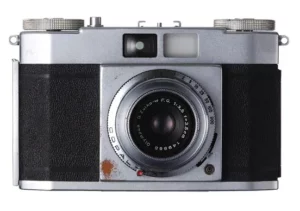
In 1955, a new sub-category of 35mm film cameras was created with the release of the Olympus Wide. As the name suggests, the key feature of the Olympus Wide was a fixed wide angle lens with a 35mm focal length. In 1957, Olympus would release two more cameras in the series which added more features, but that original model was a simple scale focus model with a 35mm f/3.5 D.Zuiko-W lens. The camera lacked a rangefinder or any type of focus aide because the increased depth of field afforded by the wide angle lens meant that estimating distance was much easier and didn’t require such precision.
Two additional models, the Olympus Wide-E and Olympus Wide-S were released in 1957 with the differences being the first had an uncoupled selenium exposure meter and the second had a faster 8-element H.Zuiko-W lens and a coupled rangefinder.
Olympus must have seen enough success with their Olympus Wide models as other Japanese companies soon followed, the first was Mamiya in 1957 with the rangefinder equipped Mamiya 35 Wide and the Mamiya 35 Wide E which replaced the rangefinder with an uncoupled selenium exposure meter. Minolta would release the Minolta Auto-Wide in 1958 which was the first wide angle model with a coupled selenium exposure meter, but no rangefinder.
Eventually Riken (Ricoh), Walz, Welmy, and Kowa would follow with similar models all featuring the same basic formula of a compact camera featuring a 35mm lens with a maximum aperture between f/2.8 or f/3.5 and some combination of a rangefinder or exposure meter.
That so many different models with a similar feature set were produced suggests there was demand for them, but that not every Japanese camera maker had a competing model, and that most of these appear to be short lived models also suggests that perhaps the demand wasn’t very high. Nevertheless, new models continued to be produced all with the same 35mm focal length until 1964 when Kowa Optical Works upped the ante with a new model they called the Kowa SW (for Super Wide). The new camera would have an all new 6-element 28mm f/3.2 lens that was wider than any lens in this class of camera.
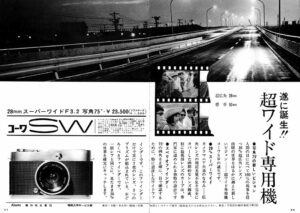
Like other fixed lens wide angle models, the Kowa SW would have a compact, all metal body with a leaf shutter with a healthy range of speeds, and a full focusing lens. The camera would be available in both chrome and a black painted finish.
Unlike the company’s previous wide angle offering, the Kowa Kallo W, the Kowa SW would neither have a rangefinder or exposure meter. With even more depth of field, the Kowa SW was effectively a focus free lens at all but the closest focus distances. With the lens set at the 3 meter mark and the diaphragm stopped down to a modest f/8, everything from 1.5 meters to 31 meters (5 feet to 101 feet) would be in focus. In addition, the lens’s 75 degree field of view meant that the camera could be shot “at the hip” with little effort required for framing, to capture candid shots without having to hold the camera to the eye.
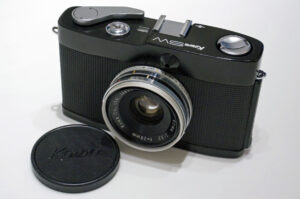
Another feature of the Kowa SW was its Kepler style viewfinder (sometimes called a Keplerian finder). I actually had to read up on what a Kepler finder was while writing this review as I had seen them before, but just didn’t know what they were called.
The name Kepler comes from Johannes Kepler, a 17th century mathematician, physicist, and astronomer. Kepler was credited for a great number of things, but one was a telescope in which he created a viewfinder that uses a convex lens as the eyepiece instead of a concave like ones that were in use at the time. The advantage to Kepler’s design is that brightness is increased, but also that the field of view was widened. A downside to the design however, is that the image is inverted, which is something that’s less of an issue while looking at a field of stars in the night sky, but a problem for a photographic camera. To counteract the inverted image, additional prisms can be used to correctly orient the image similar to how a pentaprism in an SLR works.
Kepler style viewfinders started to be used in cameras in the early 1960s with models like the Canon Demi because it allowed for a wider field of view to be shown in the viewfinder while still maintaining a bright image. Another benefit to the Kepler design is that the viewfinder glass can be made very small, reducing the space required for the optical glass. This was ideal for small half-frame cameras like the Canon Demi and the Kowa SW which had a compact body and a wide angle lens. Of course, all of the different lenses and prisms needed to make it work added complexity and cost to the camera, which is why only a few models ever used them and by the 1970s they were almost completely extinct in the photographic world.
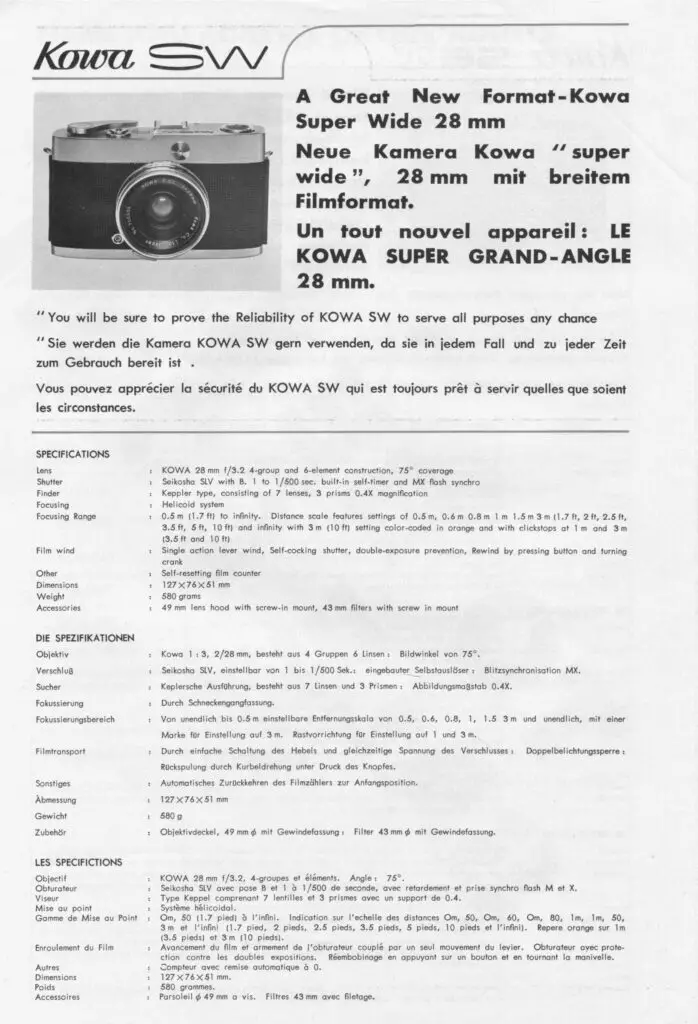
The Kowa SW, despite being made by a company with a positive reputation, having good build quality, and featuring a lens wider than any previously available on a fixed lens camera, did not sell well. As best as I can tell, it was only produced for one year. When I first started writing this article, I was convinced it was only sold in Japan as I found no evidence of it in any American publication I had access to, and nearly every reference to it online was from Japan. But then I found the English/German/French language pamphlet above for the camera suggesting it might have been exported outside of Japan.
When it sold in Japan, it had a retail price of ¥23,500 which when adjusted for inflation compares to around ¥104,000 today, which converts to about $700 in US dollars making it a bit of a pricey option for someone wanting a compact camera lacking in both a rangefinder and exposure meter. Perhaps the price and lack of what was then perceived as essential features for 1964 was the cause of its failure in the marketplace.
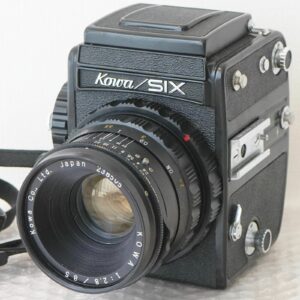
After the SW, Kowa would continue producing 35mm and 6×6 medium format SLRs until the end of the 1960s. An oversaturation of the increasingly competitive Japanese camera market and a lack of experience in electronically controlled cameras led Kowa to exit the camera making market to concentrate on lens production. Kowa still exists today as a maker of optics for the scientific and medical industries. Kowa Group’s European website claims that they employ over 7900 employees and are involved in Industrial Chemicals and the Pharmaceuticals industries.
Today, Kowa is most well known for their rangefinder and leaf shutter SLRs. Cameras like the Kowa Six were seen as cost effective alternatives to medium format SLRs like the Hasselblad, and the companies SE and SE-T series of 35mm SLRs were alternatives to models like the Kodak Retina Reflex and Zeiss-Ikon Contaflexes. Kowa was always a respected optics company, but despite also making decent cameras, never really broke out like other Japanese companies. Models like the Kowa SW are mostly forgotten, most likely due to low production, but if you’re in the market for an obscure Japanese camera with a fixed wide angle lens, it is as good as any ever made, just be prepared to open your wallet wide!
My Thoughts
I like wide angle lenses, always have, probably always will. A combination of seeing the world closer to how my eyes naturally see it, but also that wide angle lenses have wider depth of field, making focusing easier, means I can spend more time composing my images with the hope of capturing something that’s interesting to look at. Focusing slows you down, so if I don’t have to worry about it, then my images should look better…at least that’s what I tell myself.
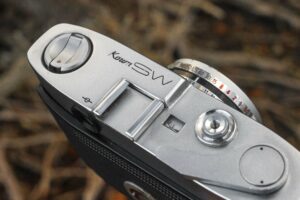
The reality is, I am just an average photographer. Sometimes I make good images, but many times I don’t. But when it comes to having fun while shooting, I find that my odds of being successful are higher with wider lenses than long ones.
The Kowa SW is an interesting camera, not just because of its 6-element 35mm lens, but also its very compact body, and very interesting Kepler style viewfinder. When looking at the front of the camera, the viewfinder doesn’t even look like a viewfinder. It resembles a metal cone, with a small piece of glass. about the size of a peppercorn at the tip.
The Kowa SW is small, but very dense. It was made during the era in which glass and metal were still king. There is no plastic or obvious weight saving materials used in its construction. At a weight of 582 grams, the camera is much heavier than its small size suggests. During the era in which this camera was made, Kowa was still a highly respected camera maker, capable of high build quality and excellent lenses. The chrome plating feels nicely applied, without any oxidation or rough edges like you might see on a lesser camera. The synthetic body covering has a squared pattern which increases grip and is made from a material that on this example, has not started to peel, chip, or flake off. The overall build quality of the camera is extremely high.
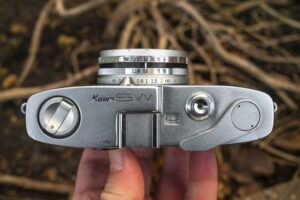
The Kowa’s top plate is clean, with each control where you expect it to be. A popup rewind knob sits in a recess which when in the down position is almost flush with the top plate, but not quite. Next is the engraved Kowa SW logo and accessory shoe. In a slightly lower step is the exposure counter, cable threaded shutter release, and rapid film advance lever. The exposure counter is additive, showing how many exposures have been made and automatically resets when opening the film back. The film advance requires a motion of about 180 degrees to completely advance the film and must be one in one single motion, multiple smaller motions will not work.
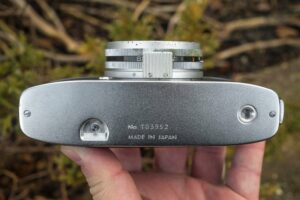
The base of the camera is more sparse than the top with only an offset 1/4″ tripod socket, rewind release button, and both the camera’s serial number and “Made in Japan” engraved in the bottom. Normally I would comment that the tripod socket is off to the side rather than in the center for balance, but that this camera is relatively small, so it likely was never an issue. From the bottom, you can also see a metal tab connected to the focus ring around the lens, which makes locating the focus control easy with the camera to your eye.
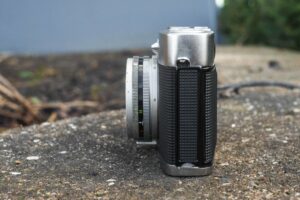
The sides of the camera have metal strap lugs on both sides, and the film door release latch on the left side. While you could argue that a neck strap isn’t a requirement for such a compact camera, that the Kowa SW offers such simple candid photography via its wide angle lens and large depth of field, having one constantly at the ready around your neck would be very useful while taking the family on a trip to the zoo or a family vacation. Looking at the camera from the side, you get a better look at the compactness of the lens, giving the camera a very slim side profile.
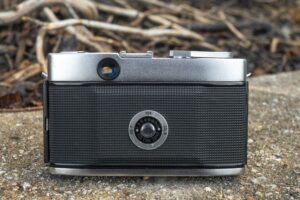
Around back, the Kowa’s clean design continues with a round eyepiece for the viewfinder, and a round film reminder dial in the center of the door. The square texture body covering from the front extends to the back and covers the entire door.
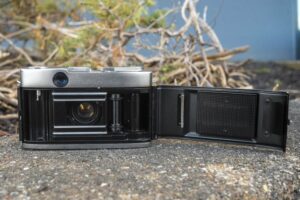
Inside the film compartment, there are no surprises. Film transports from left to right onto a non-removable metal take up spool. There are two polished metal rails above and below the film gate, the sprocket shaft is metal and the film leader attaches via a clip on the spool. Inside the film door is a large metal pressure plate covered in divots which help reduce friction as film passes over it. To the left of the pressure plate is a metal roller which helps maintain flatness as film passes over the sprocket shaft. The Kowa SW uses felt light seals on the door hinge and in the channels above and below the film gate, which on this example were still in good condition and did not need replacement.
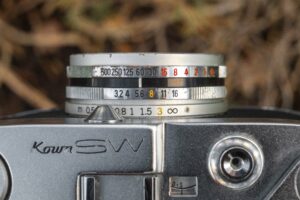
Looking down upon the shutter from the top of the camera, rings for focus, aperture, and shutter speeds are quite thin and squished together. The focus ring has a textured pad beneath the shutter that you can use to rotate the focus ring by flicking it back and forth. The entire throw of the focus ring goes from minimum to infinity focus with about a 1/8th rotation of the ring, which isn’t much, but at least lets you change distances quickly. Click stops exist at the 1 and 3 meter mark. Because of how little room there is here, the camera lacks any sort of depth of field scale which would be useful to determine “focus free” zones. While I can appreciate the shallow lens which helps maintain the overall camera compact, it comes at the expense of being able to locate these rings with the camera to your eye.
Up front, there’s almost nothing to see. At about the 1 o’clock position around the lens is the tiny opening for the viewfinder and about the 7 o’clock position is the flash sync port. The flash sync port has three positions, the green M is for flash sync with M-class bulbs, a white line in the center is the X-sync position, and a red V is the setting for the self-timer. As with all leaf shutters, you should not attempt to use the self-timer on this camera unless you are positive it works, as it can jam the mechanism if it is dirty.
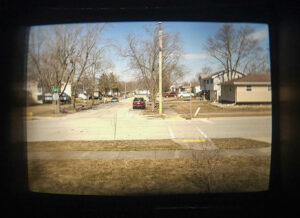
With the camera to your eye, the viewfinder is interesting. The Kowa SE uses a Kepler design which is made of 7 lens elements and 3 prisms. All that glass results in an unusually bright viewfinder. In the image to the right, I was unable to capture an image that accurately reflects how bright it is. Some of the real life look is lost when photographing a camera viewfinder with a smartphone. Looking through the eyepiece, you see a rectangle image with a pronounced convex curve to the edges which approximates the 35mm focal length of the lens, but nothing else, not even parallax correction. The image has crisp edges which are easy to see even while wearing prescription glasses. There are no frame lines, or any other settings of the camera visible, just a bright, optical rectangle.
The Kowa SW is a well made and compact camera, that doesn’t feel compact. It’s all metal body gives it a bit of heft and a feel of confident that plastic point and shoots from the decades to come don’t have. The wide depth of view of the 28mm lens means that in good lighting with the lens stopped down and focused to 10 feet, you can use it as a fixed focus camera, and the wide angle of view means that precise composition isn’t necessary.
Finally, having a 6 element glass lens from a company known for making good optics means the images you should get from this camera are quite good. The Kowa SW was only available for a short while and didn’t sell well, but on paper, this looks like a killer camera. But is it? Keep reading…
My Results
Around the same time the Kowa SW came to me, I also acquired a partial 100 foot roll of Ilford XP2 Super 400 chromogenic black and white film. This is the type of black and white film that develops in normal color C41 chemicals. This film became popular after the widespread use of minilabs at corner drug stores who didn’t have the ability to handle regular black and white anymore. Like most 400 speed black and white films, I expected some grain with average amounts of contrast and shadow detail.
To my surprise, the Ilford XP2 Super 400 film developed normally. I metered the film at 400 and made no attempts to push or pull for age. After developing the film, I scanned it into my computer with my Epson V750 in color mode. This is the same thing I’ve done with Kodak’s chromogenic black and white films as I like the slight sepia or green tints the film shows after scanning.
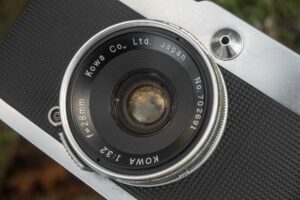
As I suspected the 6-element 28mm Kowa lens is a stunner. I don’t know if I’m just not used to seeing Ilford XP2 because I don’t shoot it as often, but the images that came off my scanner were extraordinarily sharp. I marveled at the resolution and clarity of the images. Sharpness is excellent across the image, from corner to corner. Although I only shot this one roll, I suspect that proper color film would have had an almost digital level of sharpness to them. Vignetting is visible in most images, which is completely understandable for a 28mm lens from the 1960s, but by no means does it detract from the overall look of the images. There is good vignetting, and bad vignetting, and this is definitely the former.
This being the first time ever shooting the camera, I didn’t push the camera to any limits, nor did I try any difficult shots, so most of what you see in the gallery above are all images more than 8 feet from me in mostly good lighting (I did attempt a couple low light images). The best part about using this camera in this manner is that it is effectively a fixed focus point and shoot. The Kowa SW would be an excellent camera for street photography. While the viewfinder is good, you really don’t need it. Make sure you have the right film and shutter speed for your lighting, and then walk around with this camera at your hip shooting candid photos and almost certainly, most will come out quite well.
Of course, when a camera works this well as a spontaneous candid camera, it is not the best in other situations. Closeups in poor lighting, or shots showing a lot of background blur or bokeh aren’t easy with the SW. If you like images where your subject can be isolated from the background, or you like close-ups, the Kowa SW is not for you. Perhaps this is one of the reasons this camera sold so poorly, its very good for a certain type of photography, but is less practical at most others.
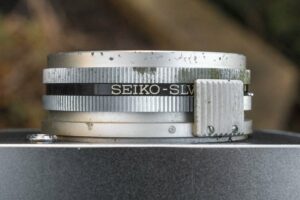
Using the camera is quite intuitive and easy, although the narrow depth of the lens means the shutter speed, aperture, and focus rings are all squished together. This isn’t much of a deal when you use the camera with a “set it and forget it” mindset, but in constantly changing lighting conditions, it can be a bit of a nuisance. At the very least, the designers were wise to add a tab to the bottom of the focus ring, so that when you do need to change distances, you don’t have to spend a lot of time fumbling around with it.
Overall, the Kowa SW is a really terrific camera that works REALLY well for the style of photography it was intended to take, although it is limited in use as a general purpose camera. If this was something you wanted to shoot regularly, you’d almost certainly need to pair it up with something a bit more flexible, or with a different set of strengths. In the era during and after the Kowa SW’s release, there were plenty of compact cameras, plenty with great lenses, and plenty that covered a 28mm focal length, but not too many can claim this specific feature set, and for that, the Kowa SW is a fantastic camera and one worth seeking out. Of course, it is not very easy to find, and prices on them can get quite high, but I’d say for most people, if this camera checks off the boxes you need checking, you’ll likely be very happy with your purchase.
Related Posts You Might Enjoy
External Links
http://camera-wiki.org/wiki/Kowa_SW
http://www.mediajoy.com/en/cla_came/KowaSW/index.html
http://shashinki.blog.fc2.com/blog-entry-285.html (in Japanese)
https://imaonline.jp/articles/editors_pick/20221011kitamura-shashinkiten/#page-1 (in Japanese)
https://www.hayatacamera.co.jp/monthlyphoto/201505/ (in Japanese)

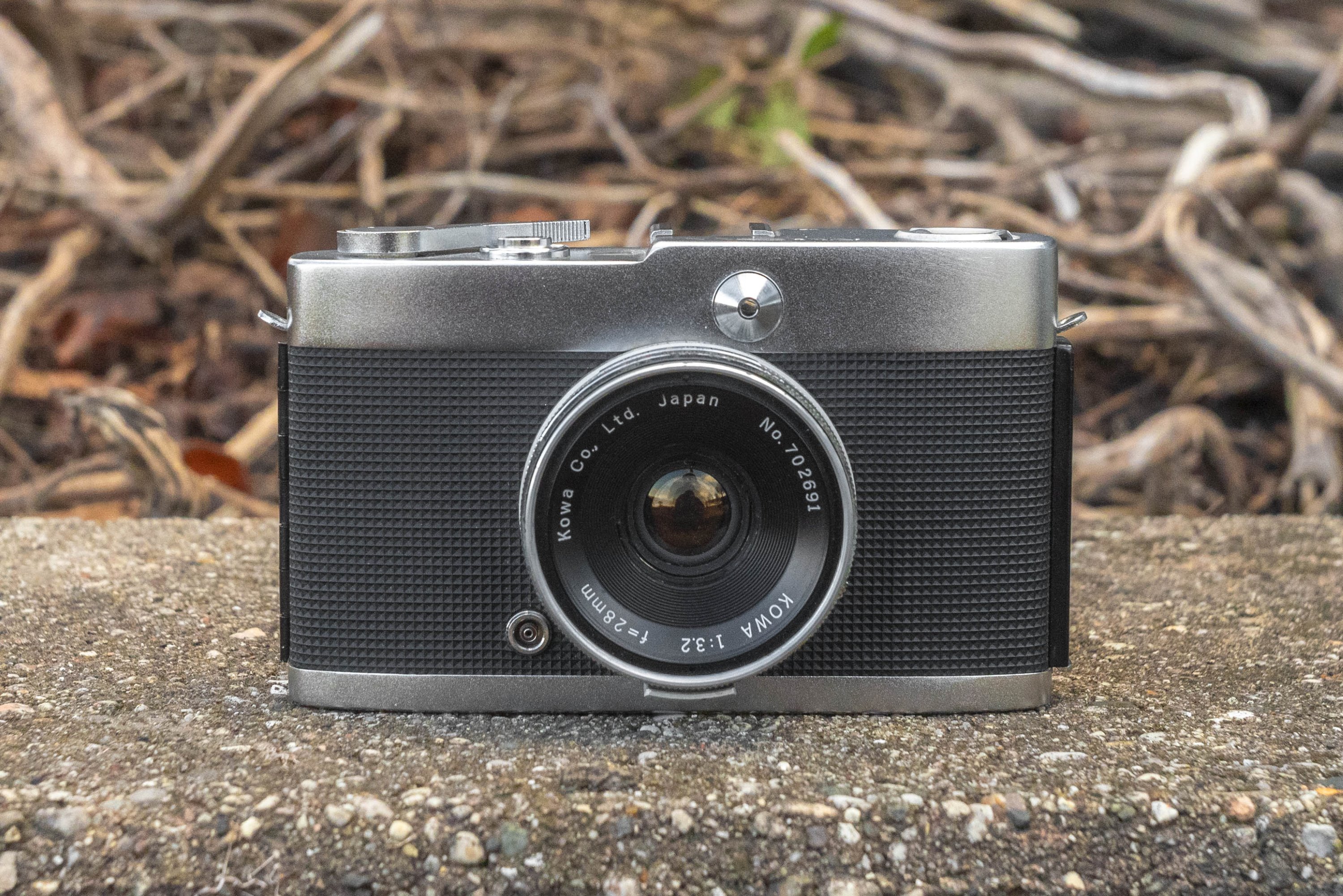
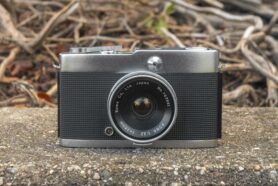
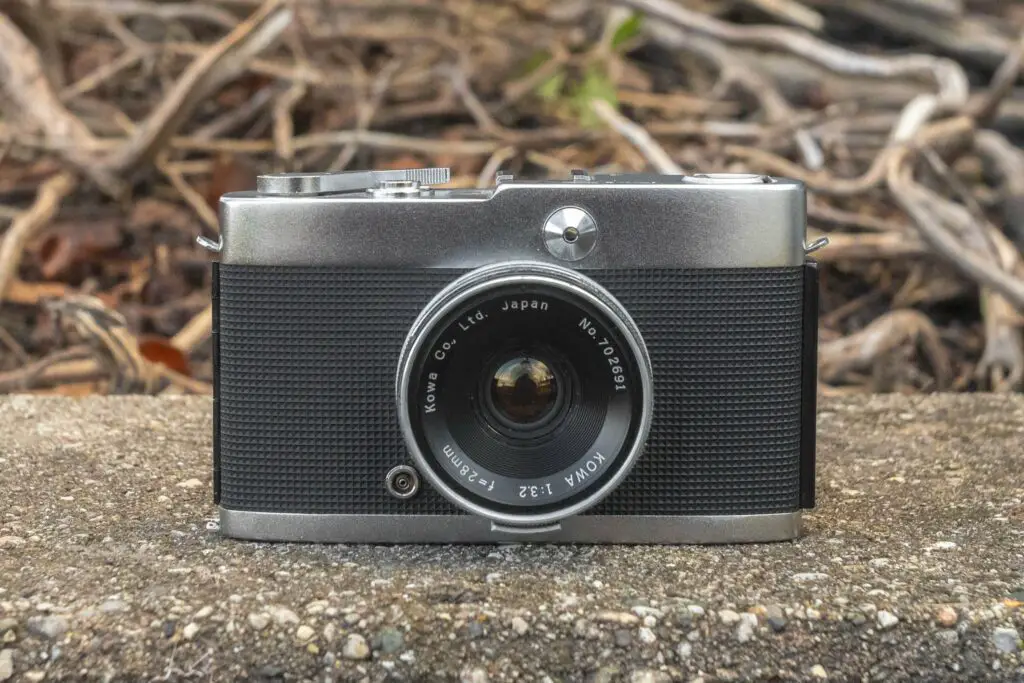
















How does the Kowa SW lens compare to that on the Hologon Ultrawide?
The two lenses are quite different. Aside from the obvious difference in focal length, 15mm vs 28mm, the Hologon lens is a much simpler 3-element design which doesn’t aim to correct for vignetting, edge distortion, or aberrations, whereas the 6-element Kowa lens does. You could say that the Kowa SW lens makes a more optically correct image, however the distortion and vignetting of the Hologon Ultrawide give it a very distinct “purposeful” image than the Kowa does. In some regards, the Kowa is just a regular camera with a wide angle lens that can be used as a carry-all point and shoot whereas the Hologon is something you’d only take out on special occasions. Both cameras are rare and quite expensive today, but in my mind, you can’t really compare the two because they each were created with different purposes in mind.
I’ll add one more thing, the Kepler viewfinder of the Kowa is quite good and a pleasure to look through, where as the one on the Hologon Ultrawide, while impressively large, is a mess. Everything but the very center is blurred and soft with vague edges. The image seen through the Hologon’s viewfinder is more like an estimation of the covered image, whereas the Kowa’s is much more authentic to the image that will be captured on film.
Thank you for this very interesting and informative review. To my mind, the Kowa SW is one of the most beautiful cameras made, and is a pleasure to use. The slim, compact size and the quiet shutter make it great for candid street photography. I’m a big fan of Kowa cameras. The Kowa Six and variants is a fantastic camera, quite the beast in size, but with a significantly quieter shutter/mirror than the Hasselblad, excellent lenses and very reasonably priced these days. I also very much like the Kowa 140, with interchangeable lenses including a 35mm f2.8, 50mm f1.4 and 85mm f3.5 and perhaps others, and the Kowa 180 with a fixed 45mm f1.8. The 140 and 180 are very nicely made leaf shutter rangefinder cameras, roughly the same size as other leaf shutter rangefinders of the era, such as the Yashica Lynx.
I am glad you enjoyed the review of the SW. I agree, it is a very attractive and easy to use camera. The first time I saw this one, I was not prepared for how small it is. I am aware of the Kowa 140 and 180 rangefinders, but have never come across one as they’re quite uncommon! Maybe some day I’ll have one! 🙂
Have you seen many of these in person? I wonder how well all the complex parts of the viewfinder hold up in general. I’m kind of obsessed with them but eBay is the most likely place to find one and a lot of the affordable ones have rough looking viewfinders. I wonder if I’d find anyone to work on one if I did have an issue?
I’ve only ever seen mine in person and although the viewfinder was clear, the lens was badly hazed up. I was able to unscrew the front elements and get it out to clean most of the haze out. Unfortunately, I did scratch some of the paint off when I was taking it apart, but otherwise it works OK.